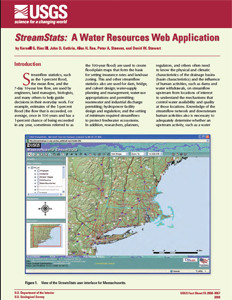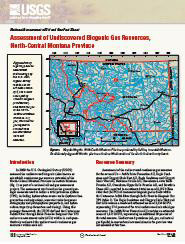
Product Details
- Product Number
- 208590
- Series
- FS-2008-3067
- Scale
- NO SCALE
- Alternate ID
- FS2008-3067
- Authors
- STEWART, DAVID W
- Version Date
- 01/01/2008
- Countries
- USA
- Media
- Paper
- Format
- Folded
Additional Details
- Description
- 11/12/2008 Streamflow statistics, such as the 1-percent flood, the mean flow, and the 7-day 10-year low flow, are used by engineers, land managers, biologists, and many others to help guide decisions in their everyday work. For example, estimates of the 1-percent flood (the flow that is exceeded, on average, once in 100 years and has a 1-percent chance of being exceeded in any year, sometimes referred to as the 100-year flood) are used to create flood-plain maps that form the basis for setting insurance rates and land-use zoning. This and other streamflow statistics also are used for dam, bridge, and culvert design; water- supply planning and management; water-use appropriations and permitting; wastewater and industrial discharge permitting; hydropower facility design and regulation; and the setting of minimum required streamflows to protect freshwater ecosystems. In addition, researchers, planners, regulators, and others often need to know the physical and climatic characteristics of the drainage basins (basin characteristics) and the influence of human activities, such as dams and water withdrawals, on streamflow upstream from locations of interest to understand the mechanisms that control water availability and quality at those locations. Knowledge of the streamflow network and downstream human activities also is necessary to adequately determine whether an upstream activity, such as a water withdrawal, can be allowed without adversely affecting downstream activities. Streamflow statistics could be needed at any location along a stream. Most often, streamflow statistics are needed at ungaged sites, where no streamflow data are available to compute the statistics. At U.S. Geological Survey (USGS) streamflow data-collection stations, which include streamgaging stations, partial- record stations, and miscellaneous-measurement stations, streamflow statistics can be computed from available data for the stations. Streamflow data are collected continuously at streamgaging stations. Streamflow measurements are collected systematically over a period of years at partial-record stations to estimate peak-flow or low-flow statistics. Streamflow measurements usually are collected at miscellaneous-measurement stations for specific hydrologic studies with various objectives. StreamStats is a Web-based Geographic Information System (GIS) application (fig. 1) that was created by the USGS, in cooperation with Environmental Systems Research Institute, Inc. (ESRI)1, to provide users with access to an assortment of analytical tools that are useful for water-resources planning and management. StreamStats functionality is based on ESRI's ArcHydro Data Model and Tools, described on the Web at http://support.esri.com/index.cfm? fa=downloads.dataModels.filteredGateway<(>&<)>dmid=15. StreamStats allows users to easily obtain streamflow statistics, basin characteristics, and descriptive information for USGS data-collection stations and user- selected ungaged sites. It also allows users to identify stream reaches that are upstream and downstream from user-selected sites, and to identify and obtain information for locations along the streams where activities that may affect streamflow conditions are occurring. This functionality can be accessed through a map-based user interface that appears in the user's Web browser (fig. 1), or individual functions can be requested remotely as Web services by other Web or desktop computer applications. StreamStats can perform these analyses much faster than historically used manual techniques. StreamStats was designed so that each state would be implemented as a separate application, with a reliance on local partnerships to fund the individual applications, and a goal of eventual full national implementation. Idaho became the first state to implement StreamStats in 2003. By mid-2008, 14 states had applications available to the public, and 18 other states were in various stages of implementation.
- Survey Date
- 2008
- Print Date
- 2008
- Height In Inches
- 11.000
- Length In Inches
- 8.500
- Two Sided
- Yes
- Pieces
- 1
- Languages
- English
Related Items





